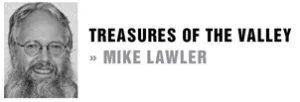It always amazes both newcomers to CV and long-time residents what a wealth of historical events of a global nature have taken place in, or are connected with, our sleepy valley. But we are also connected geographically to events of a galactic nature with the proximity of Mt. Wilson to CV.
A defining feature of our community are the mountains that loom over us, and we’re all familiar with the peaks of Mt. Lukens and Mt. Wilson, both of which sport myriad communications antennas that distinguish them from the other peaks of the San Gabriel’s. Many of us have taken drives to Mt. Wilson to visit the snow or for incredible views of the city lights, but few of us have visited Mt. Wilson’s real claim to fame – the world-class observatories that have been built there over the last hundred years.
I recently took a drive up there for one of their free public tours of the observatory grounds and found it to be one of the best local trips I’ve taken in years. The drive up is spectacular, taking you through the heart of the fire-blasted wilderness. Angeles Crest Highway is closed, so you have to take the back way in, driving up Big Tujunga Canyon. Turn left at Angeles Forest Highway, right at Upper Tujunga Canyon Road, and right again at Angeles Crest Highway, which takes you shortly to the Mt. Wilson Road. The trip is slightly longer, but worth it, as you pass through ghostly forests of burnt trees, moonscapes of denuded land, and the wreckage of burnt houses. From this sobering landscape you transition into the thick forests around Mt. Wilson that were saved by firefighters’ superhuman efforts.
After passing massive communications antennas, you enter Skyline Park, which is open from 10 a.m. to 4 p.m. every day, April 1 through Nov. 30. There you will find a covered pavilion where free tours of the observatory are given on Saturdays and Sundays at 1:00 p.m.
These tours are eye openers, as you find out that for most of the last century Mt. Wilson was the best and biggest observatory in the world, and the foundations of our knowledge of space were discovered there, just minutes from CV. It was proved at this observatory that there are galaxies outside our own Milky Way, leading to the discoveries of thousands of other galaxies. It was here that astronomers found that our universe is expanding – the “Big Bang” theory. At one point in the tour, you pass by a photo of Albert Einstein and you realize from the background that he is standing on the very spot you are standing.
Visitors can watch current solar observations being taken though a century-old telescope still in use, and enter the dome of the 100-inch telescope, where names such as Hale and Hubble made their marks on astronomy. On the tour you will visit the modern work being done there, such as the new CHARA array telescope that just this year made ground-breaking discoveries and observations of an eclipse in a distant star system.
The tours are given by retired astronomer types, and you find yourself infected with their passion for space exploration.
When the tour is over, more treats await. The pavilion is home to the Cosmic Café, where one can get snacks or a full meal, and sit at tables looking out over the city, or beneath well-visited hummingbird feeders. Unique offerings like pine-nut hummus with flatbread and fresh cucumber are reasonably priced, along with traditional hot dogs and chips, and a full array of hot and cold drinks.
Several hiking trails branch out from the peak and amazing views are at every turn. It’s a great get-away from a hot summer day as the temperature is always mild on the mountaintop. Be aware that technically you’re supposed to have a “Discover Pass” parking permit to park in National Forest land. Be sure to get up there before the end of November as they’re closed during the winter.
This is a great afternoon outing in a rarely visited portion of our own backyard.
Mike Lawler is the president of the Historical Society of the Crescenta Valley. Reach him at lawlerdad@yahoo.com.

